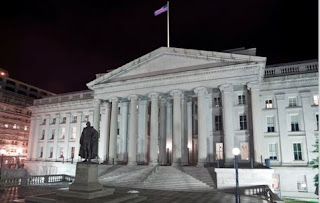Iwalked Washington DC's Treasury Building - The Treasury Building is the oldest executive department within the United States federal government and also one of the largest with over 100,000 employees. Despite being housed in one of the biggest governmental buildings in all of Washington, it is said that only about ten percent of its work force can be accommodated here. The Treasury department was formally established by an act of Congress on September 2, 1789 with the general objectives of managing the government’s revenue through such activities as producing currency, collecting taxes and managing all public debt. Just nine days after the department’s creation the first Secretary of the Treasury was sworn in, Alexander Hamilton.
 |
| Treasury Building |
Four-story Structure
The Treasury Building is a massive four-story structure that claims to be the largest Greek Revival building in the world. It encompasses two full city blocks and covers five acres of space. The original T-shaped structure (consisting of the central and eastern wings) was designed by architect Robert Mills and constructed over a period from 1836 to 1842. Mill’s design was largely unpopular by Congress who fretted that the mountainous structure would block the White House’s view to the east. Mills snubbed the remarks and continued with his prodigious efforts. For his insubordination, Mills would be released from his post of chief architect for the Treasury Building in 1851.
Prior to his dismissal though, Mills managed to create a magnificent sandstone and granite structure that integrated a series of thirty Ionic columns along its 15th Street facade. Each of these columns stands thirty-six feet tall, weighs thirty tons and was reportedly carved out of a single piece of granite. The costs incurred to construct and install each column were reported to be $5,000 each.
Despite Congress’ apparent concern over the size of the Treasury Building, expansions to the structure would ensue over three more periods. The first addition occurred from 1855-1860 when a wing was added along the south side (giving the building an upside down F-shape). This wing was designed by the architectural team of Ammi B. Young (who also designed Boston’s Custom House) and Alexander H. Bowman. An addition along the west wing shortly followed suit during 1855-1864. This façade that features ten columns along its exterior was designed by Isaiah Rogers. The final wing addition occurred along the north side and was built between 1868 and 1869. This addition, which would enclose the structure, was designed by Alfred B. Mullett who also oversaw construction of the Eisenhower Executive Office Building.
Reservations
Free guided tours of the Treasury Building are available upon reservations with your local Congressman. One hour tours are typically offered on Saturdays during the times of 9:00, 9:45, 10:30 and 11:45 a.m. All visitors should arrive via the building’s southern entrance and request access via the call button along the gated fence.
The tour includes a number of highlights to captivate your attention. Visitors are provided the opportunity to visit a former office that was used by President Andrew Jackson for a period after Abraham Lincoln’s death in 1865.
You will likely be in awe within the two-story Cash Room that was constructed of eight different varieties of marble. And a visit to the basement will provide some insight as to the current and prior usages of the fifteen vaults that reside here, including one vault from 1864 that is claimed to be burglar proof. The vaults range in size from 160 square feet to 4,500 square feet, and originally housed currency here from 1863-1880. During the Civil War, the vaults were primarily used for food and weapons storage.
Also located within the basement are shooting ranges used for the training of the Secret Service and other law enforcement agencies. Unfortunately visitors are not allowed to partake in this area. Another commonly mistaken element that visitors anticipate viewing is the production of currency. This actually occurs within the Bureau of Engraving and Printing, where visitors are actually provided the opportunity to watch George Washingtons, Abraham Lincolns, or larger bills roll off the presses.
Two significant statues reside along the building’s north and south facades. These portrait figures are dedicated to Alexander Hamilton and Albert Gallatin. Also, if you catch yourself walking along the western façade of the Treasury Building keep your eyes peeled for a reproduction of the Liberty Bell which resides here.
- Website: http://www.treasury.gov/about/education/Pages/edu_fact-sheets_building_history.aspx
- Address:1500 Pennsylvania Avenue, NW,Washington,DC
- Cost: Free
